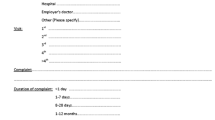Abstract
Acute otitis media (AOM) is common in Indian children, but there is limited published information on its clinic prevalence, clinicians’ diagnostic practices, and their management strategies. We approached 649 ear-nose-throat (ENT) surgeons to assess these aspects of AOM. We conducted the survey between May 2010 and February 2011 with the same set of ENT surgeons practising across India, once each during summer, monsoon and winter, using a validated 36-item questionnaire to record their reflective recall. 78 % (506/649) of approached ENT surgeons responded. The clinic prevalence of AOM was 43 % with peaks reported in July and December. 96 % (486/506) of the surgeons used otoscopy to diagnose AOM. 86 % (435/506) prescribed analgesics, and 89 % (449/506) prescribed decongestants. 98 % (495/506) treated AOM with an antibiotic at initial consultation: amoxicillin/clavulanic acid 78 % (395/506), amoxicillin 29 % (144/506), cefpodoxime 29 % (149/506), cefixime 28 % (141/506) and azithromycin 27 % (134/506). Amoxicillin/clavulanic acid 32 % (162/506) and cefpodoxime 27% (137/506) were mostly prescribed for relapse. The average reported duration of initial antibiotic therapy was 7 days and for relapse was 9 days. The reported clinic prevalence of AOM was higher (43 %) than anticipated (about 10 %) in ENT practice. Almost all the ENT surgeons used an otoscope to diagnose AOM. Amoxicillin/clavulanic acid was the preferred antibiotic for treating AOM either initially or for relapse. Most surgeons also used analgesics and decongestants for symptomatic relief.



Similar content being viewed by others
References
Rupa V, Jacob A, Joseph A (1999) Chronic suppurative otitis media: prevalence and practices among rural south Indian children. Int J Pediatr Otorhinolaryngol 48:217–221
Jacob A, Rupa V, Job A, Joseph A (1997) Hearing impairment and otitis media in a rural primary school in south India. Int J Pediatr Otorhinolaryngol 39:133–138
Sophia A, Isaac R, Rebekah G, Brahmadathan K, Rupa V (2010) Risk factors for otitis media among preschool, rural Indian children. Int J Pediatr Otorhinolaryngol 74:677–683
Williams G, Ramachandran K, Nall L, Fong J, Mathews J (2009) Management of post-infectious olfactory dysfunction: a nationwide survey of UK ENT consultants. B-ENT 5:163–167
Gaur K, Kasliwal N, Bhandari A, Amisha B, Gupta V, Gupta R (2009) Changing trends in otorhinolaryngological diseases at a non government clinic in Jaipur. Indian J Otolaryngol Head Neck Surg 61:173–178
Auinger P, Lanphear B, Kalkwarf H, Mansour M (2003) Trends in otitis media among children in the United States. Pediatrics 112:514–520
Kerschner JE (2007) Otitis media. In: Kliegman R, Marcdante K, Jenson H, Behrman R (eds) Nelsons text book of pediatrics, 18th edn. Saunders, Philadelphia, pp 2632–2646
Teele D, Klein J, Rosner B (1989) Epidemiology of otitis media during the first seven years of life in children in greater Boston: a prospective, cohort study. J Infect Dis 160:83–94
Zaman K, Baqui AH, Yunus M, Sack RB, Bateman OM, Chowdhury HR, Black RE (1997) Acute respiratory infections in children: a community-based longitudinal study in rural Bangladesh. J Trop Pediatr 43:133–137
Rao BL, Banerjee K (1993) Influenza surveillance in Pune, India, 1978–90. Bull World Health Organ 71:177–181
Laine MK, Tähtinen PA, Ruuskanen O, Huovinen P, Ruohola A (2010) Symptoms or symptom-based scores cannot predict acute otitis media at otitis-prone age. Pediatrics 125:e1154–e1161
Ruuskanen O, Heikkinen T (1994) Otitis media: etiology and diagnosis. Pediatr Infect Dis J 13:S23–S26
de Melker RA (1993) Evaluation of the diagnostic value of pneumatic otoscopy in primary care using the results of tympanometry as a reference standard. Br J Gen Pract 43:22–24
Pichichero ME (2000) Acute otitis media: part I. Improving diagnostic accuracy. Am Fam Physician 61:2051–2056
American Academy of Pediatrics and American Academy of Family Physicians (2004) Clinical practice guideline, subcommittee on management of acute otitis media. Diagnosis and management of acute otitis media. Pediatrics 113:1451–1465
Klein JO (2011) Is acute otitis media a treatable disease? N Engl J Med 364:168–169
IAP Respiratory Chapter (2012) Protocols in pulmonology. http://www.iaprespiratory.org/index.html. Accessed 15 March 2012
Courter JD, Baker WL, Nowak KS, Smogowicz LA, Desjardins LL, Coleman CI et al (2010) Increased clinical failures when treating acute otitis media with macrolides: a meta-analysis. Ann Pharmacother 44:471–478
Coleman C, Moore M (2008) Decongestants and antihistamines for acute otitis media in children. Cochrane Database Syst Rev 16(3):CD001727
MacArthur CJ, DeGagne JM, Kempton JB, Trune DR (2009) Steroid control of acute middle ear inflammation in a mouse model. Arch Otolaryngol Head Neck Surg 135:453–457
Acknowledgments
“We thank Dr. E. V. Raman and his team at Center for Otitis Media Research and Education (CORE) for ratifying the questionnaire for content validity. We thank Drs. Chinnappa J, Kukreja S, Mankekar G, Prabhat D, Rai D, Raman E V and Ugra D, for their contribution towards interpretation of findings from this survey and for review of the manuscript.” This questionnaire survey was funded by GlaxoSmithKline Pharmaceuticals Ltd. (GSK), Mumbai. This work is attributed to GlaxoSmithKline Pharmaceuticals Ltd. Mumbai.
Conflict of interest
Dr. Arun Nanivadekar is an independent medical research consultant who received a fee from GSK for advice on this project.
Author information
Authors and Affiliations
Corresponding author
Rights and permissions
About this article
Cite this article
D’silva, L., Parikh, R., Nanivadekar, A. et al. A Questionnaire-Based Survey of Indian ENT Surgeons to Estimate Clinic Prevalence of Acute Otitis Media, Diagnostic Practices, and Management Strategies. Indian J Otolaryngol Head Neck Surg 65 (Suppl 3), 575–581 (2013). https://doi.org/10.1007/s12070-012-0545-2
Received:
Accepted:
Published:
Issue Date:
DOI: https://doi.org/10.1007/s12070-012-0545-2




